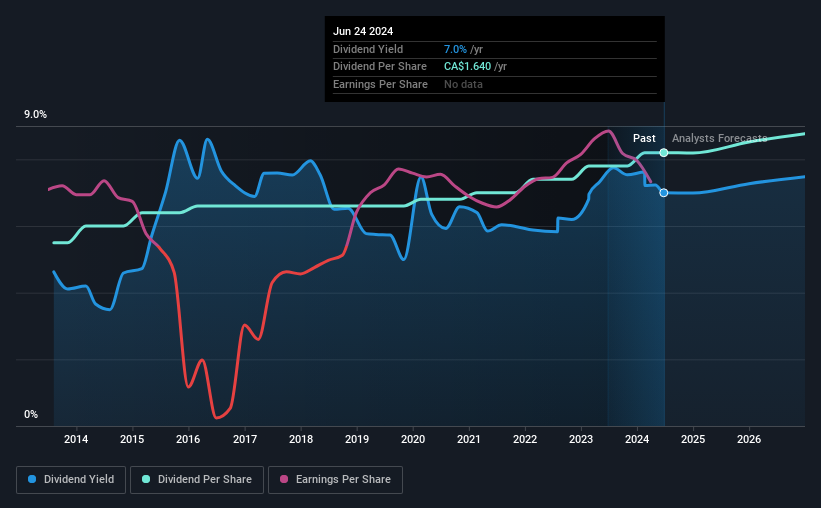Two Days Left To Buy Gibson Energy Inc. (TSE:GEI) Before The Ex-Dividend Date
Regular readers will know that we love our dividends at Simply Wall St, which is why it's exciting to see Gibson Energy Inc. (TSE:GEI) is about to trade ex-dividend in the next 2 days. The ex-dividend date occurs one day before the record date which is the day on which shareholders need to be on the company's books in order to receive a dividend. The ex-dividend date is important because any transaction on a stock needs to have been settled before the record date in order to be eligible for a dividend. Meaning, you will need to purchase Gibson Energy's shares before the 28th of June to receive the dividend, which will be paid on the 17th of July.
The company's next dividend payment will be CA$0.41 per share, on the back of last year when the company paid a total of CA$1.64 to shareholders. Based on the last year's worth of payments, Gibson Energy stock has a trailing yield of around 7.0% on the current share price of CA$23.44. If you buy this business for its dividend, you should have an idea of whether Gibson Energy's dividend is reliable and sustainable. As a result, readers should always check whether Gibson Energy has been able to grow its dividends, or if the dividend might be cut.
See our latest analysis for Gibson Energy
Dividends are typically paid from company earnings. If a company pays more in dividends than it earned in profit, then the dividend could be unsustainable. Gibson Energy distributed an unsustainably high 147% of its profit as dividends to shareholders last year. Without more sustainable payment behaviour, the dividend looks precarious. A useful secondary check can be to evaluate whether Gibson Energy generated enough free cash flow to afford its dividend. Over the last year it paid out 52% of its free cash flow as dividends, within the usual range for most companies.
It's disappointing to see that the dividend was not covered by profits, but cash is more important from a dividend sustainability perspective, and Gibson Energy fortunately did generate enough cash to fund its dividend. Still, if the company repeatedly paid a dividend greater than its profits, we'd be concerned. Extraordinarily few companies are capable of persistently paying a dividend that is greater than their profits.
Click here to see the company's payout ratio, plus analyst estimates of its future dividends.
Have Earnings And Dividends Been Growing?
Stocks in companies that generate sustainable earnings growth often make the best dividend prospects, as it is easier to lift the dividend when earnings are rising. If earnings fall far enough, the company could be forced to cut its dividend. Fortunately for readers, Gibson Energy's earnings per share have been growing at 13% a year for the past five years.
Gibson Energy also issued more than 5% of its market cap in new stock during the past year, which we feel is likely to hurt its dividend prospects in the long run. It's hard to grow dividends per share when a company keeps creating new shares.
The main way most investors will assess a company's dividend prospects is by checking the historical rate of dividend growth. Gibson Energy has delivered 4.1% dividend growth per year on average over the past 10 years. It's good to see both earnings and the dividend have improved - although the former has been rising much quicker than the latter, possibly due to the company reinvesting more of its profits in growth.
The Bottom Line
Has Gibson Energy got what it takes to maintain its dividend payments? Growing earnings per share and a normal cashflow payout ratio is an ok combination, but we're concerned that the company is paying out such a high percentage of its income as dividends. While it does have some good things going for it, we're a bit ambivalent and it would take more to convince us of Gibson Energy's dividend merits.
So if you want to do more digging on Gibson Energy, you'll find it worthwhile knowing the risks that this stock faces. To that end, you should learn about the 4 warning signs we've spotted with Gibson Energy (including 1 which shouldn't be ignored).
Generally, we wouldn't recommend just buying the first dividend stock you see. Here's a curated list of interesting stocks that are strong dividend payers.
Have feedback on this article? Concerned about the content? Get in touch with us directly. Alternatively, email editorial-team (at) simplywallst.com.
This article by Simply Wall St is general in nature. We provide commentary based on historical data and analyst forecasts only using an unbiased methodology and our articles are not intended to be financial advice. It does not constitute a recommendation to buy or sell any stock, and does not take account of your objectives, or your financial situation. We aim to bring you long-term focused analysis driven by fundamental data. Note that our analysis may not factor in the latest price-sensitive company announcements or qualitative material. Simply Wall St has no position in any stocks mentioned.
Have feedback on this article? Concerned about the content? Get in touch with us directly. Alternatively, email editorial-team@simplywallst.com

 Yahoo Finance
Yahoo Finance 
